Where to go in Switzerland on a short trip: Alps, lakes, and cities
Switzerland is an extremely popular country for those planning multi-stop tours around Europe, yet very few potential first-time visitors actually know specifically where they want to go. Everyone seems to know that it has the most beautiful views of the Alps and some very impressive cities, but there are actually many misconceptions among casual trip planners, so I’d like to clear most of that up below. The places to visit in Switzerland are not obvious until you’ve been there yourself or done many hours of research, so the list below should be a short cut.
I get hundreds if not thousands of itinerary questions for people who are considering a Eurail trip around Europe, and most people just include the word “Switzerland” among a list of cities like Paris, Rome, and Berlin that they want to visit. So where in Switzerland should you go if you can only make a few stops at most? I’ll answer that question below.
Note: This article was expanded and updated in February, 2024.
Switzerland is about outdoor views rather than city visits
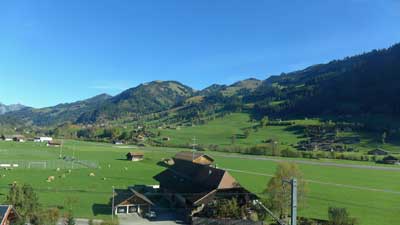
Geneva is a very famous city (though not for tourism reasons) on a lovely lake of the same name, but it’s also notoriously dull and lacking distinction. Rick Steves puts it well by saying that “Geneva is pleasantly situated on a lake, like Buffalo or Cleveland.” The point is, you don’t want to go to Geneva unless you’ve got something specific in mind that you want to see there.
Switzerland's cities in summary
Zurich – The largest city, very expensive, geared towards business travelers. It’s generally a pretty and very well-run city that you would enjoy if you visited, but it’s not nearly as interesting as the likes of Vienna, Munich, or of course Paris.
Geneva – Second largest city, in the French part of the country, no major sights. Again, if you visited you’d be very impressed by it and get some great photos, but it’s not worth your time unless you know someone there. There’s an impressive fountain in the lake and you can usually see it from the train as you go through the city, but it’s not really worth going there and staying more than an hour or so.
Basel – Bordering France and Germany, no major sights. It has the famous art market each year, and aside from that it’s even duller than the ones above. Again, if you visited you’d be impressed, but if you later compared photos with friends who went to the Lauterbrunnen Valley instead, you’d kick yourself for going to Basel.
Lausanne – Near Geneva in the French part of the country, very hilly, and certainly more interesting than Geneva.
Bern – The capital, compact, on a lovely river, some interesting sights and the best Swiss city to get a feel for the culture. Bern is fairly close to Interlaken (which we will discuss below) and it can be a great day trip from there, especially on a day where it is foggy and/or rainy in the mountains (and this happens a LOT).
How much time and which Swiss cities to visit?
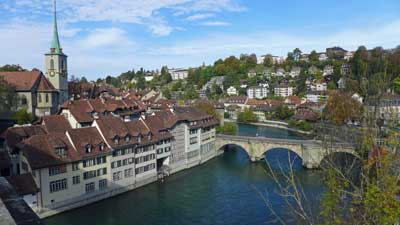
Many people (me included) don’t feel as if they’ve scratched the surface of a new country if they haven’t spent at least a day or two in the largest city. Zurich is certainly pleasant and a useful transit hub so spending one or two nights there wouldn’t be a major mistake. But Zurich isn’t even close to being a city like Paris, Rome, Berlin, Amsterdam, or even Vienna. If you skip it in favor of spending more time in the outdoors, you won’t be missing much.
The 2 Swiss places to focus on for short visits
Interlaken – If you want the best possible Alpine views and activities, head to the Interlaken area, which will be described in detail below.
Lucerne – The traditional Swiss tourist retreat, Lucerne is a small city with interesting culture and sights, that is gorgeously set on a lake with plenty of top activities surrounding it.
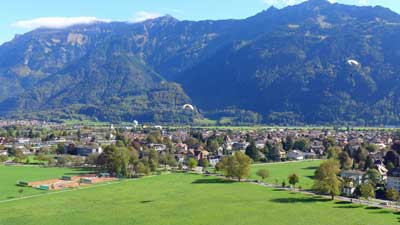
>>>Interlaken and Lucerne: Which to choose and how long to stay in each?
The article linked above will give you more details on which to choose and how long to spend in each place.
What about Zermatt for Alpine views?
Zermatt is a remote car-free village in southern Switzerland that is famous for being the place to see the Matterhorn mountain. It’s also a busy ski resort area, and aside from that, there isn’t much to see or do here. It’s on a private rail line, so it’s more complicated and usually more expensive to reach than Interlaken.
In other words, unless you’ve irrationally placed “Seeing the Matterhorn in person” on your so-called bucket list, skip Zermatt and head to Interlaken on a shorter visit. You won’t be sorry. If you already have enough time in your visit for the main sights around Interlaken and Lucerne and you want to also see the Matterhorn, then by all means go and you’ll enjoy it. There are quite a few other car-free villages in the Lauterbrunnen Valley near Interlaken, so they are not as novel in Switzerland as one might expect.
A weekend in Switzerland?
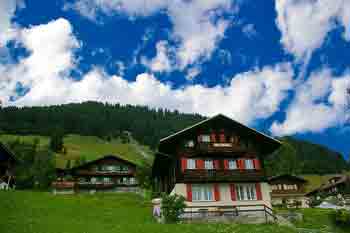
One challenge is that neither has an international airport so you’ll either be flying into Zurich or perhaps Geneva.
Train times from Zurich to Lucerne to Interlaken and back
- Zurich Airport to Lucerne: 1 hour 10 minutes by train
- Lucerne to Interlaken: 2 hours by train
- Interlaken to Zurich Airport: 2 hours 15 minutes by train
As you can see with the travel times above, Zurich Airport to Lucerne is a fairly short trip, but once you add Interlaken into the mix (even if you skip Lucerne) the travel time starts to add up for a weekend visit. With this in mind it’s probably best to just choose one of them and save the other one for another trip.
Lucerne is gorgeous, but the Lauterbrunnen Valley near Interlaken is really the star of the show, so I’d recommend going there first and doing Lucerne on another trip.
What about the Swiss Travel Pass?
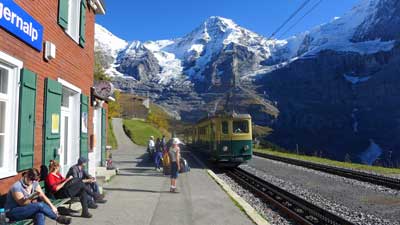
The bottom line is that if you are coming to Switzerland for at least 3 days and you want to take 2 or more of the amazing scenic rail journeys that the country is famous for, the travel pass is probably a good deal. It also provides 50% discounts on the Schilthorn cable car and 25% off the Jungfraujoch mountain railway. Both of those are quite expensive on their own, but extremely worthwhile, so the discount is helpful.
The Half Fare Card is probably a better deal for most people
The Swiss Travel Pass is a good deal for those who are going to be spending at least 2 or 3 days riding the rails and seeing Switzerland that way. But if you are mostly going to be focusing on Interlaken and Lucerne and the mountain sights, the Half Fare Card is the best option. For CHF120 (about US$134) you get the card that is good for 30 days and gives you a 50% discount on all trains, cable cars, mountain railways, and other sights and attractions. If you are doing either Schilthorn or Jungfraujoch, the Half Fare Card practically pays for itself with just one of those.
>>>Buy the Swiss Half Fare Card
Many people have questions about the Swiss Half Fare Card so I will explain it a bit here. You can actually buy half price train tickets for travel within Switzerland any time you want and you will see that option when you go to buy them online. The only thing is you have to have and present a valid Half Fare Card when you get on the train and are asked to see your ticket. In other words, you can buy a half fare train ticket today and buy a Half Fare Card just before you get on that train months in the future, and you are fine.
How and why visit the area around Interlaken
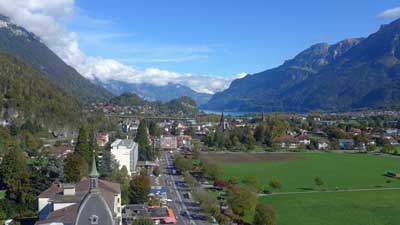
You can see everything discussed below by actually staying in a hotel in Interlaken, but it’s not the Alpine experience that you get if you stay in one of the small villages nearby. You can reach those villages in 20 to 40 minutes from the Interlaken Ost (East) train station, and it’s much easier than it sounds.
The 3 best places to stay to visit the Swiss Alps
Lauterbrunnen – A private train line runs from Interlaken Ost station to the end of its line in Lauterbrunnen. There’s a lovely waterfall here and great hiking trails, but you should probably only stay here if you can’t get to one of the villages mentioned just below. It’s a great little transit hub and it’s definitely gorgeous, so it can be worth a night if you’ve got one to spare.
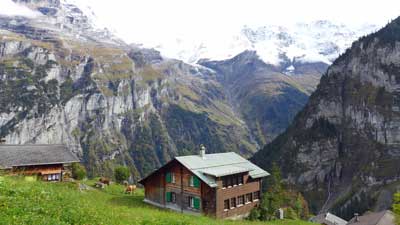
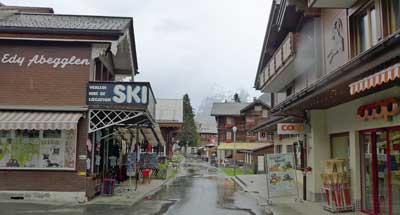
Where to stay in Interlaken and the Lauterbrunnen Valley (with pics)
I get so many questions about where to stay in the Interlaken area that I decided to write a longer version of it and load it with huge photos so readers can get a better feel for each option. I also included recommendations for affordable and well-located photos in each area.
>>>Where to stay in Interlaken and the Lauterbrunnen Valley New for 2024!
The unforgettable things to see here (if the weather is decent)
Schilthorn observation deck and restaurant
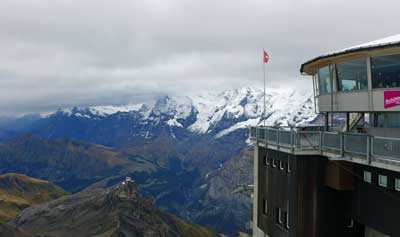
There is a rotating restaurant (with prices similar to normal Swiss restaurants) and a bizarre and anachronistic James Bond attraction based on it being a key location in the 1969 movie On Her Majesty’s Secret Service. The Bond thing is included with the lift, and it’s worth a look.
But the main thing you come here for is the 360-degree view from one of the highest peaks in Europe. Again, the weather here is key, but fortunately all the locals track the visibility on a minute-by-minute basis. If it’s clear up top while you are in the area, it would be a terrible shame to skip it based on the high price. But even if it’s cloudy up top, there are still plenty of wonderful things to see and do in the villages below.
Jungfraujoch observation area
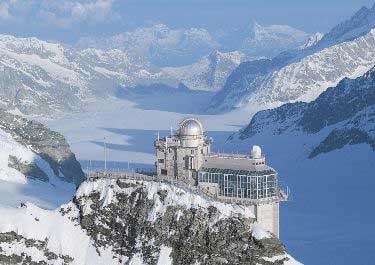
The views from the top are similar to the views from Schilthorn, from the other side of the Lauterbrunnen Valley. Once on top you can have lunch, hike, or even go sledding. It’s also quite expensive at nearly US$200 round-trip unless you have a Swiss Pass or a Eurail Pass for discounts, and it takes most of your day, but you’ll never forget the views from the top.
Harder Kulm mountain and Two Lakes Bridge Observation Deck
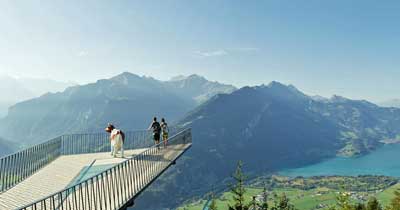
There’s a revolving restaurant about 10 minutes’ walk from the station at the top, which is definitely an unforgettable place for lunch if you’ve got time. It’s not as expensive as you might expect, at least compared to normal restaurants in Switzerland.
The Harder Kulm Railway goes from early April through late November each year. If you are only in Interlaken for one day and/or you are on a strict budget, this is the fastest and best way to get amazing Alpine views in the area.
Getting from Interlaken to Gimmelwald and Mürren
Getting up to these villages sounds complicated and time consuming, but it’s actually fast and easy once you get there. This little guide should help.
Arrive in Interlaken
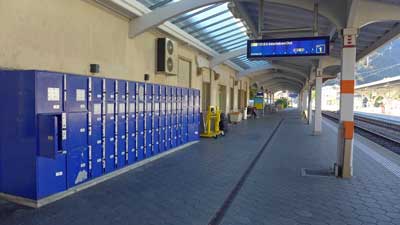
Once you arrive at the Interlaken Ost train station, head for the ticket windows in the office and buy a ticket to your final destination (Lauterbrunnen, Gimmelwald, or Mürren). Eurail passes are good for 25% discounts on the rest of the trip, but not for the whole thing.
From Interlaken Ost to Lauterbrunnen
The private train leaves Interlaken Ost every 30 minutes and arrives in Lauterbrunnen 20 minutes later. If you are staying in Lauterbrunnen then you are probably walking distance from your hotel when you reach the station.
From Lauterbrunnen to Gimmelwald
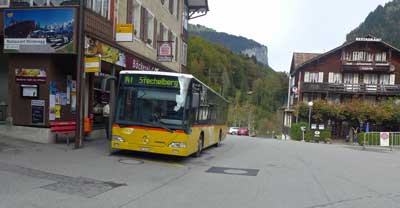
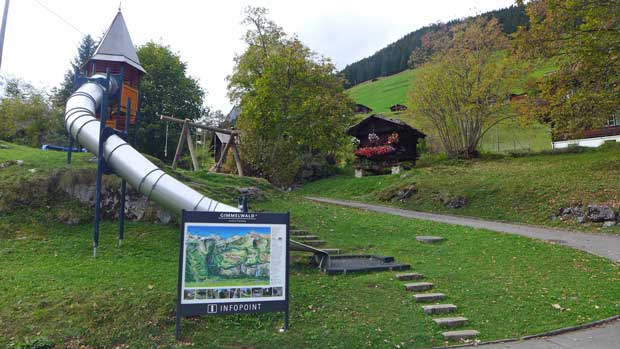
From
Gimmelwald to Mürren
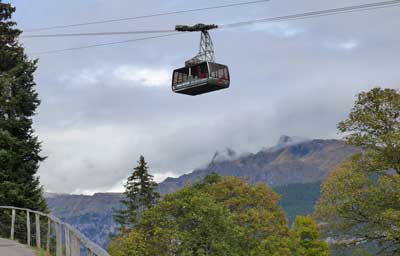
Recommended hotel and hostel in Gimmelwald
I get asked all the time about where to stay in Gimmelwald, so here it is:
Hotel: Esther’s Guesthouse
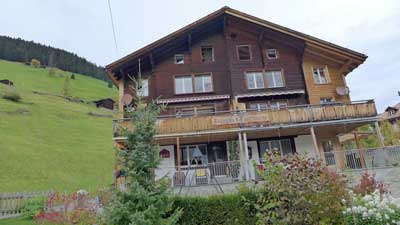
It’s run by Esther, as you might guess, and she is very friendly speaking excellent English. Each room is different and the place feels like a mountain cabin, because it is. She offers an excellent buffet breakfast in the morning, which you have to order the night before. It’s not cheap, but it’s worth it because it’s hearty and there are no other good options nearby.
Book as early as possible because this place is often the first place to sell out in Gimmelwald.
Hostel: Mountain Hostel Gimmelwald
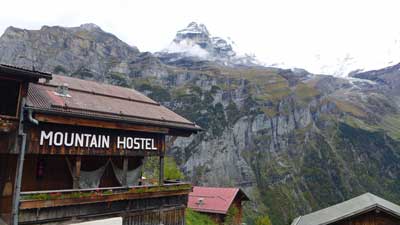
You won’t believe the views from this place, which are the same as from Esther’s except a bit lower and more unobstructed. This place also has a busy bar and restaurant that is basically the only “nightlife” in Gimmelwald. Many hikers get to bed early in this tiny village, but if you want to have a couple drinks and order a pizza or some local options, this is the place to go.
Again, book early because this place is always sold out.
Lucerne and what to do there
Luzern, as it’s spelled locally, is the other traditional holiday destination in Switzerland. Unlike Interlaken, Lucerne actually qualifies as a small city rather than a small resort town, so it’s a very nice contrast and very worthwhile.
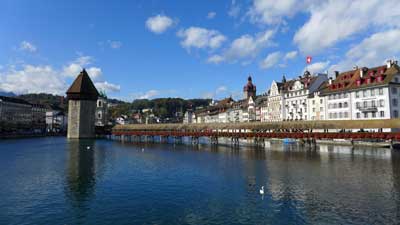
However, unlike Interlaken, the town of Lucerne itself is a great attraction and worth at least a day of exploration. This has always been a rich area so you can expect to find all of the high-end shops and boutiques along the small streets just north of the lake, but there are also many traditional shops and things to see that will appeal to anyone.
Recommended hotel in Lucerne
>>Hotel Des Alpes (3 stars with an amazing location and view)
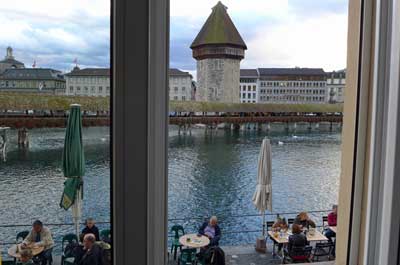
If this place is booked, which is often the case, then book a hotel as close to it as you can find or afford. The whole historic part of town surrounding it is lovely, with restaurants, bars, and high-end shops. There are also a couple of nearby supermarkets where you can buy inexpensive alcohol and picnic supplies to keep other costs down.
Spend a day in Lucerne itself
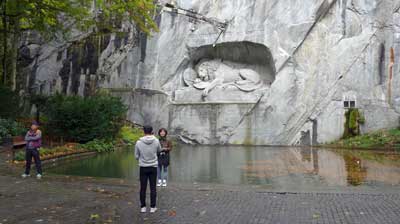
Most of the interesting part of Lucerne is in the area behind those restaurants, and it’s certainly worth doing a self-guided walking tour if not a guided one. Heading farther east you’ll come to another older part of town where the famous lion statue is located. You can’t visit Lucerne without having a look at the lion, and fortunately it’s easy and quick to reach (and it’s free).
Take a lake cruise of some kind
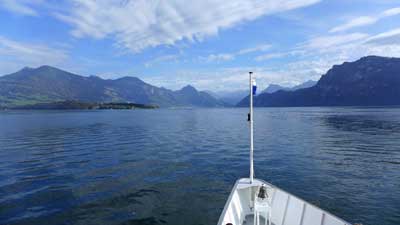
Especially in nice weather, even the short lake tour is lovely, and if you have more time you can jump off at Vitznau and do the scenic hike up Mount Rigi. There are also small lakeside villages that are ideal for a stroll and lunch stop. Long story short, there are dozens of interesting sightseeing options that are available using part of the boat tour, and the views all around are wonderful.
Visit Mount Pilatus
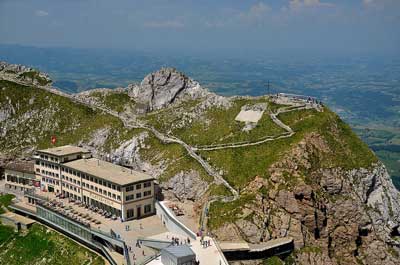
You can take the cogwheel train up and have a more or less flat hike around the summit area, and then take the gondola and cable car back down again. You can do them in the other order, and the cost is the same either way. At around US$65, this is not a cheap hike, but like most everything in Switzerland, the quality is high so it doesn’t feel like a rip-off. You can reach the cable car in 10 minutes on a public trolly bus from Lucerne.
Visit Mount Rigi
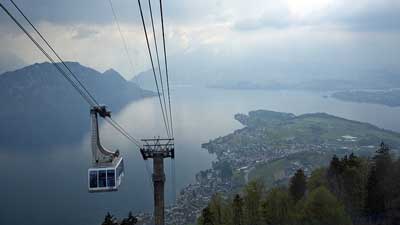
Unlike the other peaks mentioned in this article the Swiss Travel Pass covers both ways to get up and down for free. The others are 50% off with the Swiss Travel Pass or Half Fare Card, except for Jungfraujoch, which is only 25% off with the Swiss Travel Pass and still 50% off with the Half Fare Card.
Visit Mount Titlis
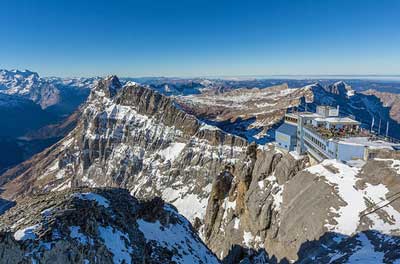
You can reach Titlis by taking a 43-minute train ride from Lucerne to Engelburg and then taking the cable car up from there. As with the others, it’s wise to check the weather immediately before you are going to depart because it can be foggy or cloudy any time of the year, but usually not for whole days at a time.
Additional photo credits
Jungfraujoch by cupweuro on Flickr, Pilatus by Tony Fernandez on Flickr, Rigi by Kosala Bandara on Flickr, Titlis by PaulSchliebs on Flickr

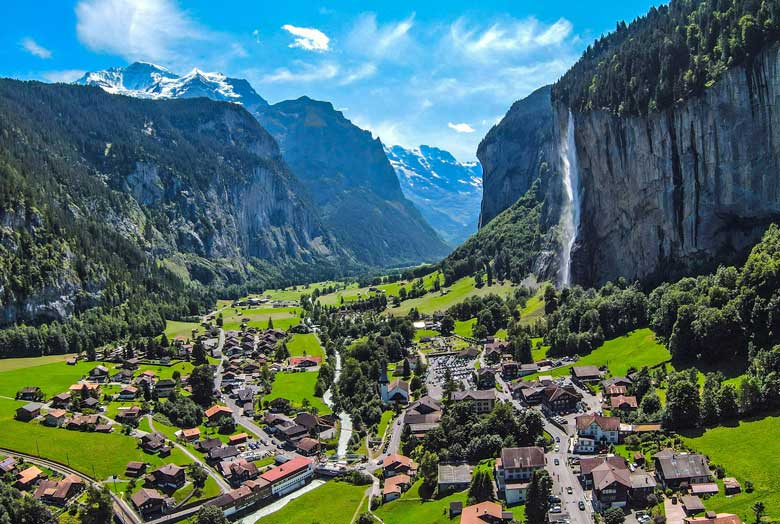
Comment*This info is a godsend! I’m going to be travelling from Rome to Wengen in May and I am still unsure about where to stop for one night as we make our way north. We only have two nights in Wengen so I didn’t want to get to the area too terribly late in the day. Had thought about overnighting in Domodossola as a cheaper and not too far away stop. I’ve spent time in that town before and thought it would be an easy, relaxing place to stop. I’ve never been to Lugano so I had also considered stopping there. Would it make sense to take a scenic train from there into Switzerland to make our way to Wengen or would that be a complete time suck? After Wengen we are spending two nights in Lucerne and then flying home. Any thoughts on an option that would give us the most bang for our buck?
E.
I’m glad you found it useful. The idea of a scenic train from Lugano into the Interlaken area sounds fantastic. Wengen is one of those very small villages that is unbelievably scenic, but if you can combine that with one of those epic train journeys, I think it would be worth it. And since you are also going to spend two days in Lucerne, you’ll have plenty of time to see a couple of the major peaks or other sights there, including the lake cruise, of course. Let me know if you have any other questions. -Roger
Hi Roger,
Thank you for all the valuable tips about Swiss Travel Pass and where to stay on a short visit.
This will be our 1st and only trip to Switzerland. We will be flying into Basel airport, April 15 evening and staying in an Airbnb in Egolzwil, Lucern till April 21 flying out of Zurich back to Canada. Can you please suggest realistically what duration of days I should buy the STP for and I would like to see at least 1 of the alps, likely Jungfraujoch.
Any other itinerary suggestions from you would be GREATLY appreciated.
Many thanks
Betsy
Betsy,
I’m not really familiar with Egolzwil, but I see it on the map and I’m sure it’s nice. Since you won’t be staying too close to Lucerne or Interlaken I would think that the Swiss Travel Pass would be even more valuable on your trip. In other words, you’ll be riding trains every day just to get to the sights. I’d probably look at the 6-day pass and then probably use it from your first day as I’d think Basel to Egolzwil would be more expensive than Egolzwil to Zurich Airport, although I could be wrong. And depending on what time your flights are, you might just opt for the 8-day version as it’s only 30 CHF more so if you plan on doing a bit of sightseeing on your arrival day and your departure day, it would save money.
Jungfrau only gets a 50% discount with the pass, but most of the trains to get there are included and it’s definitely worth it. You can also easily visit Rigi or the other peaks closer to Lucerne pretty easily. And definitely plan at least two days in the Lauterbrunnen Valley or even three if you include Jungfraujoch. It’s the most dramatic scenery in the area and there are various cable cars and mountain trains that you can take, and most or all of those will be included with the pass. I hope this helps and let me know if you have any other questions. -Roger
Comment*
Thank you Roger!
I do have a follow up question, regarding the STP panoramic train routes.
In particular the shorter routes- Lötschberg Mountain Railway the GoldenPass, Voralpen-Express and Emmental route. Are these return trips? Is there a full day route you would recommend instead so we have exposure to other areas in Switzerland? It’s unfortunate the Chocolate scenic route opens only in May.
We have 5 full dates to explore. April 16-20. We will do Schilthorn 1 day and surrounding below valley hiking and 1-2 days in Lauterbrunnen Valley as you suggest and 1 day in Lucerne.
Your comments and suggestions are appreciated.
Betsy
This article was very useful and direct. If we have 4 nights in Switzerland pre-cruise (3 full days since the first and last days are transit days), would you recommend going straight to Mürren or splitting time 2/2 nights between Lucerne & Murren. We fly mid day into Zurich from the US and the cruise departs from Basel.
Joan,
I’m glad it was helpful. That’s a tough call. I think two days in the Lauterbrunnen Valley and one day in Lucerne is probably more interesting than 3 days in the valley, so if you don’t mind the extra (also gorgeous) train trip to Lucerne, I would do it that way. That said, there is a lot to do and see around Murren so I’m sure you’d enjoy it if you stayed. The town of Lucerne itself is a real highlight so you can’t go wrong either way. I think if you have the energy and budget to add a day in Lucerne, do it. -Roger
Hi Roger,
Excellent work and very helpful,thank you.
Il be in Athens this nov and wondering if it’s worth to make a trip/stay to gimmelwald/murren/the peaks end of Nov. Does the cable cars and trains operate all year?
Thanks and Regards,
Pradeep
Pradeep,
That is a very interesting question. The Schilthorn cable car shuts down for a month or so each autumn for maintenance and this year it looks like it’s going to be 14-November through 9-December, and that includes that portion from the valley floor up to Gimmelwald and Murren. Even the funicular that goes up to Murren from a different place will be shut down from mid October until 9-December. Murren is a fairly large village and it looks like they have a back-up cable car for freight during the scheduled closings. Anyway, it unfortunately is not a good time to visit those villages.
On the other hand, Wengen and Grindelwald are similar villages on the other side of the valley and they are accessible all year round. And the Jungfraujoch railway to the “top of Europe” runs every day of the year, so that is an interesting alternative. Personally I find Gimmelwald the most charming of the villages because it’s so tiny, but they are all gorgeous and amazing so I think you’d enjoy it. I hope that helps. -Roger
Hi Roger,
Thank you so much. Helps immensely with my planning.
If I take the global train pass, Is the half fare card or swiss travel pass still worth it?
Thinking to cover Italy, France and swiss and hence the question. Il mostly fly into Naples and then by train everywhere else.
Regards,
Pradeep
Hi Roger,
Thanks for the amazing information. I actually been in Switzerland couple of times but only passing by. I used to sky in Tignes, Val D’Isére, 3 Valleys and really want to visit the Dolomiti one day for sure. I haven’t skied for more than 10 years but i want to take my other half and her son which is also ten years old to see the mountains. They not even seen snow before! I’m very tight on schedule and booked for late November, wanted to go to Aguilli du Midi in Chamonix (closed for maintenance) and then Interlaken, Jungfrau and Zermatt on the way back but just don’t have the time. I arrive in Geneva at 11:00 in the morning in a Friday and go home Sunday 16:30 flight to Portugal. So still don’t know if i hire a car and go Interlaken, Jungfrau and Zermatt or train or another itinerary. We are going in this off season so it’s quiet and cheaper. Don’t know about the passes, that’s why if better by car or train. I just want then to feel the mountains, get the Alpine feel and Majestic of the Alps that i miss so much. I just wish i had more time but that’s it, maybe in March we all go skiing! As a conclusion i don’t want then to be really tired but to enjoy these 2.5 days let’s say. Thanks and keep the amazing experiences coming and the help to the community. All the best from Portugal.
Joao,
I’m glad you have enjoyed the information. As you’ve discovered, this is a tricky situation. Mid October through November is considered the off season in the Swiss mountains and most hotels and restaurants close down during this period. This is because it’s too cold for hiking and most other outdoor activities, and there usually isn’t enough snow for skiing yet. I believe most ski lifts traditionally start in the first week of December each year. I suppose there is a chance of early snow and an early ski season, but probably even a better chance for a late start to the season.
That said, there is snow all year round on the tops of the highest peaks, including Jungfrau. So you can take the Jungfraujoch railway and it will be plenty of snow on top. And there is a decent chance that there will be at least some snow in Murren and Grindelwald. It’s also true that some hotels and restaurants will be open during this period, so if you can get a reservation you should be fine and the crowds will be very small.
I know less about Zermatt and I highly recommend the Lauterbrunnen Valley near Interlaken in general because there is far more to see and do there. I’d take trains, which in Switzerland usually don’t struggle in poor weather, while driving can be tough if you get unlucky. It can be foggy or cloudy at the tops of the peaks any day of the year in Switzerland, and that obviously means November as well. Another nice thing about the Interlaken area is there are things to do in town even if the peaks are cloudy (there is no point in paying a lot to go up Jungfraujoch or Schiltorn if it’s foggy up there), and you can also take a train to Bern in 60 minutes, which is another worthwhile city to visit. I hope this helps at least a bit and let me know if you have any other questions. -Roger
Hello Roger, while doing research on traveling to Switzerland, I found your site and am loving all of the wonderful information. I am in the midst of planning my 50th birthday trip (Dec. 4th) (originally planned for Antarctica but canceled due to covid).
I’m concerned because I see that many places may be close during the dates I would like to travel. My plan was to go 7 days. I would prefer being in Switzerland during my birthday but could travel a little later. I have to be back to the states by Dec. 15th so I have basically a window of November 26 – Dec. 15th. I would love to see maybe a day in Zurich and then the rest of the time exploring all of the natural beauty in Bern, Interlaken and Lucerne. What do you recommend in terms of dates and how to split between my cities of interest. Also, if you suggest leaving one of the cities off, which would it be? Thanks so much for your help!
Robby
Robby,
I’m glad you are finding this information useful and it’s nice to get these kinds of questions again. Generally speaking, many of the smaller hotels and restaurants in the mountain villages close from mid October until mid December, but some of them stay open. They sometimes do cable car maintenance during this period as well, but I don’t think it’s on a fixed schedule. It will be chilly in the mountains in late November, yet the snow season doesn’t typically start until mid December, which is why some places close. I think you’d have plenty to do during those dates even if a couple things were closed. It’s a stunning part of the world and sometimes even nicer when the crowds are smallest.
As I often mention, Zurich isn’t very interesting (and it’s very expensive), so I’d probably leave that off. It’s not even the capital and there are really no must-see attractions. I’d spend 3 nights in Interlaken and 2 or 3 nights in Lucerne. You can see Bern on a day trip from Interlaken or spend a night there. I’m happy to help if you have more questions and let’s hope this will be a safe time to explore Switzerland this year. -Roger
Hi Roger,
Your expertise and input is very much appreciated. We are 6 people traveling next August from Dublin. If we fly into Zurich, how long are the train rides to travel to Interlaken, Lucerne, etc. We will have about 6 days. Any help on what the highlights should be?
Thank you!
Joanne
Joanne,
From the Zurich Airport it’s only about an hour by train to Lucerne. From Lucerne it’s about two hours to Interlaken. With 6 days you’ll be able to see most of the best highlights. I’d go right from the airport to Interlaken and spend 3 days there. Then go back to Lucerne for two or three days. You could also do a side trip to Bern from Interlaken or a side trip to Zurich on your last day or departure day.
That should be a good plan to get you started and I’m happy to answer more questions as your trip comes together. -Roger
Hi Roger,
What an invaluable support you are providing to clueless tourists like me…thanks so much!
This is my plan and we are 4 adults and 2 kids on this trip.
Flying in Jul
Day 1 Arrive at Zurich – Bern
Day 2 Bern
Day 3 Bern – Interlaken
Day 4 Bern – Zermatt
Day 5 Bern – Montreaux
Day 6 Bern – Lucerne
Day 7 Lucerne – Mt. Pilatus
Day 8 Lucerne
Day 9 Lucerne – Zurich
Day 10 Flyout from Zurich
Pls advise the kind of pass we should buy.
Thanks again!
Ruhi,
It’s kind of tough to know with confidence unless I were to add all of those train rides up. My hunch is that the Half Fare Card would be best and then you can purchase a Saver Day Pass for the days where you’ll be taking the long or expensive train rides. Those are basically a one-day Swiss Travel Pass and you can buy them for CHF39 if you buy them at least two weeks in advance and if you have the Half Fare Card as well. Let me know if you have any other questions. -Roger
Hi Roger,
Waiting for your reply.